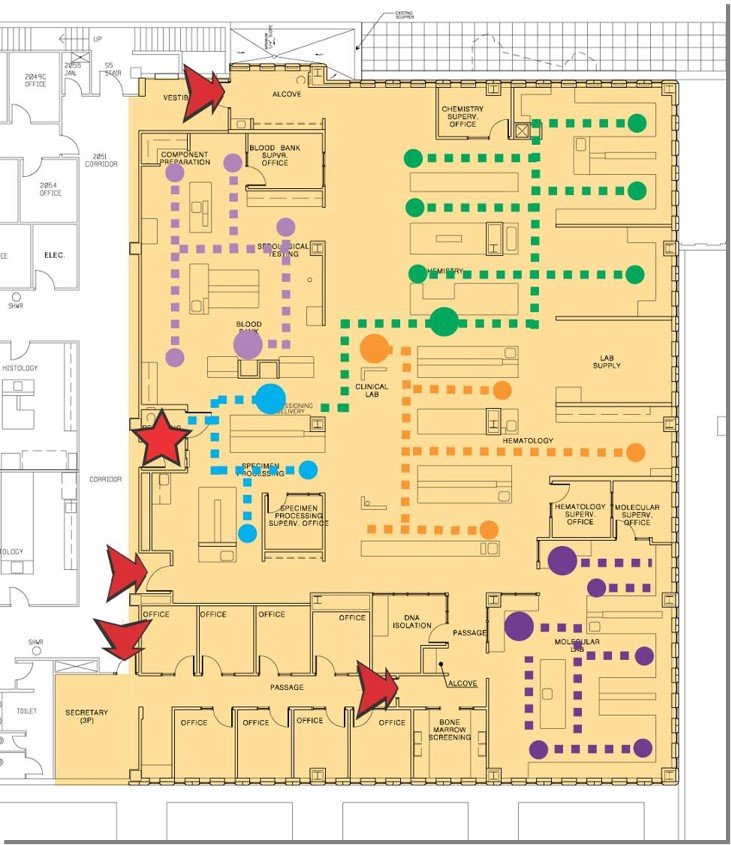Planning Approach for Diagnostic Laboratories
Fully automated and modular diagnostics system, scalable for future growth.
SMRT INC.
Diagnostic laboratories such as clinical and anatomical pathology are very process driven, and supported by state of the art equipment for speed and accuracy. Efficiency of workflow and chain of custody are also drivers in the design of these facilities. Here are some things to consider when developing a plan for building or renovating a diagnostic laboratory.
Workflow
Diagnostic laboratories such as clinical and anatomical pathology are very process driven, and supported by state of the art equipment for speed and accuracy. Efficiency of workflow and chain of custody are also drivers in the design of these facilities. Here are some things to consider when developing a plan for building or renovating a diagnostic laboratory.
Prior to the commencement of design work, it is necessary to understand the workflow anticipated in the laboratory. There will be different paths for normal sample testing and analysis and more specific processing, such as for stat samples in support of surgery. Locations of intake points as well as output points (waste and storage) will be located within the overall context of the building. From the moment of intake, samples should have been coded and at each station the code read for information tracking. The aliquot process will prepare the samples for their path through the lab. For initial planning the workflow process is represented in a flow diagram which can then be translated into a bubble diagram of the steps on a sample’s journey through the lab facility. The strategy of the laboratory should be an efficient one, with minimal sample transfers and minimal distance between stations. At the end of the process some samples may need to be retained; ample storage must be provided for that. Upon completion, samples are stored and disposed of at the appropriate area of the building.
Quantity and nature of samples
As the process is one which relies on equipment throughput, an analysis of normal sample volume projections must be completed in order to describe the amount of equipment needed. As we would like to get as much production from the equipment as possible, hours of operation should be determined with the lab management. This will determine the amount of staff and shifts needed to operate the facility. Provision should also be made for downtime of the equipment with back-up plans established as well as a certain amount of redundancy. Typical samples would be routinely routed through the process while others such as tissue from surgery would not be part of an established routine. Those would need to be handled on an individual basis with more individual involvement as opposed to automation.
Equipment and automation
These are the workhorses of the lab. They must be placed appropriately to the flow of the materials in the lab with adequate clearances for operation and maintenance. Utilities must also be well managed for location and service. As many of the operations of this equipment is repetitive, proper ergonomics of the workstations must be provided, as well as opportunities for respite during the work shift.
Specialty labs and spaces
Flow diagrams assist in layouts and adjacencies for the new clinical laboratory at Moffitt Cancer Center.
GRESHAM, SMITH AND PARTNERS
These may include stat labs, frozen sections, microscopy and others which do not fall in the category of normal throughput but require unique operations which may or may not lend themselves to automation. Pathology offices will also have a space for multiple headed microscopes through which a team of pathologists can review a sample for diagnosis. General reading stations would also be contiguous with the lab—although through data transfer, these stations could be remote. Other spaces which will support the laboratory include mechanical and electrical rooms, gas cylinder rooms, materials storage, samples storage, and hazardous waste holding, to name a few.
Lean design
It becomes apparent that since these laboratories are so process and throughput driven, a Lean approach may be warranted. Minimizing steps and actions will not only make the workflow more efficient, it will also increase safety and reduce errors. This Lean analysis should be done early on during the flow diagram and bubble diagram stage. Relationships between intake, workstations, and storage and waste holding should be evaluated and designed to optimize throughput.
Emerging equipment and technologies
One thing that is always certain is change—equipment becomes more efficient, and new equipment which may bring automation to a previously manual task may come on the market. These emerging technologies, although potentially unpredictable, need to be provided for in the design of the laboratory. Appropriate service alleys and maintenance points are ways to allow change to occur in a non-disruptive way. Adequate services such as power, air, and vacuum should be provided or should be able to be expanded. During the initial schematic stage of the design effort, an analysis of potential future automation and technology should occur in order to locate “placeholders” for emerging equipment.


